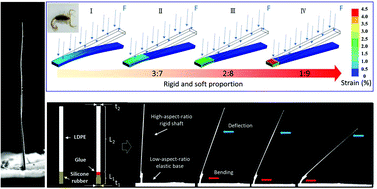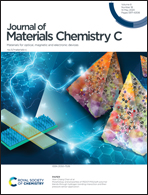High-aspect-ratio deflection transducers inspired by the ultra-sensitive cantilever configuration of scorpion trichobothria†
Abstract
Ultra-sensitive cantilever transducers are always considered as a platform for the next generation of physical, chemical, and biological sensors. However, it is still a significant challenge to design artificial ultra-sensitive cantilever transducers, especially with a simple structure using a simple method and materials. A scorpion can sense extremely small air flow using only the simple cantilever-like trichobothria on its pedipalp. It can transduce micro airflow signals into deflection without bending. It was shown that the trichobothria in scorpion are mainly made up of two parts: the low-aspect-ratio elastic tissue and the high-aspect-ratio rigid hair shaft. More importantly, the aspect ratio and stiffness of the rigid hair shaft are extremely larger than those of the elastic tissue. Due to these special material and structural characteristics, the cantilever can achieve a high aspect ratio. Inspired by this principle, herein, a kind of deflection transducer with a high aspect ratio was designed. The results confirm that the designed transducer can also catch the stimulus signals by deflection, which can better concentrate stress. Moreover, this kind of transducer has higher sensitivity, easy fabrication, and low cost. Therefore, it is expected that this kind of new bioinspired sensor can be well-applied in many important engineering fields.



 Please wait while we load your content...
Please wait while we load your content...